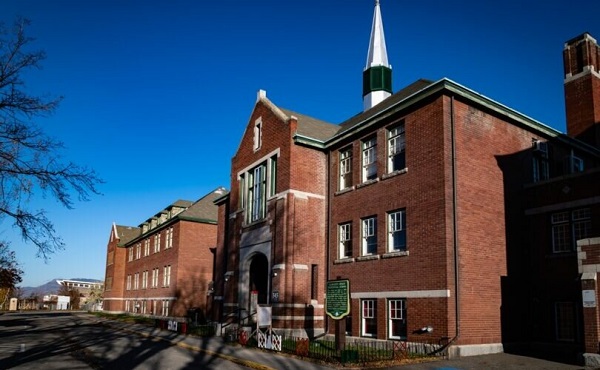City of Red Deer
Molly Banister Drive extension remains a possibility as City Council shelves development plans for creek-side lots

From the City of Red Deer
Molly Banister Drive extension to remain in plans
On September 10, Council gave first reading to a report regarding the future of Molly Banister Drive extension. The administrative report recommended removal of the protected alignment from the development plans, meaning the roadway would come out of the plans, and development of the area could continue without holding space for this road to be developed at some point in the future.
Tonight, Council heard from 31 people who spoke either for or against the protection of the road alignment at a public hearing. Due to COVID-19 restrictions, residents voiced their opinions either at an offsite location via video to Council, or over the phone.
Following the public hearing, and consideration of the written statements received, Council began deliberations in consideration of second and third reading of the amendment.
Currently, The City’s statutory plans show the protected alignment as a four lane undivided arterial road, similar to 22 Street between 30 Avenue and 40 Avenue, bisecting Piper Creek. Tonight, Council voted against removing the protected alignment, which keeps this potential road as an option to accommodate traffic in the city’s southeast when the population of Red Deer is about 188,000 people.
The Molly Banister Drive alignment was projected to be required when the population of Red Deer reaches 188,000, which is estimated to be in about 34 years, in 2054.
“The discussion of whether or not Molly Banister Drive should be extended has been a recurring topic for many years,” said Deputy Mayor Michael Dawe. “The Molly Banister Drive extension was first shown in City planning and transportation documents in the 1970’s, and after considering input from the many residents who joined us tonight or submitted feedback in advance, Council decided not to proceed with second and third reading, which keeps the protected alignment in development plans.”
In the fall of 2019, The City received an application to amend two development plans in the East Hill area. Melcor, the developer of the area, requested that the Municipal Development Plan (MDP) and the East Hill Major Area Structure Plan (MASP) be amended by removing the Molly Banister Drive protected roadway alignment (extension of Molly Banister Drive to 40 Avenue) from the plans.
More information can be found at www.reddeer.ca/mollybanister.
City of Red Deer
City of Red Deer Employee Honoured with Bob Stollings Memorial Award for Outstanding Contributions

Annette Scheper, Community & Program Facilitator in the Safe & Healthy Communities Department is The City’s 2025 recipient of the Bob Stollings Memorial Award.
The Bob Stollings Memorial Award is given out each year to a City employee who displays outstanding performance in alignment with The City’s RISE cornerstone values – respect, integrity, service and excellence. Nominations for the award are submitted by fellow coworkers detailing the employee’s achievements professionally and interpersonally, along with letters of support. The award is considered a great honour among City staff.
With an impressive 22-year career, Annette has played a pivotal role in shaping Red Deer’s cultural and special events landscape. Her leadership and innovation have brought thousands of successful events to life, creating lasting traditions that enrich the lives of residents. Her commitment to excellence and resourcefulness has ensured that community initiatives are inclusive, accessible, and impactful.
One of Annette’s most notable achievements is the development of the Community Loan Program, which provides essential resources for local groups, contributing an annual value of $86,778.95 back into the community. In addition, she has successfully led and executed a variety of large-scale events, demonstrating remarkable problem-solving skills and a dedication to sustainability. From creating elaborate event designs with repurposed materials to managing complex logistics, she continuously sets the standard for excellence.
“Annette exemplifies the best of our organization,” said City Manager, Tara Lodewyk. “Her unwavering dedication, innovative thinking, and ability to bring people together has made a profound impact on our city. This award is a testament to her hard work and passion for creating meaningful experiences for our community.”
The Bob Stollings Memorial Award was first established in 1985 and is presented every year to honour Robert (Bob) E. Stollings, a loyal and dedicated City employee from 1960-1984.
City of Red Deer
Red Deer will choose a new Mayor as Ken Johnston decides to step away

It’s a telling detail about the person who leads Red Deer City Council. Always putting the city’s needs ahead of his own, Mayor Ken Johnston has announced his intentions within days of the opening of Nominations for October’s municipal elections,
After 12 years on council, Mayor Ken Johnston has decided against running for a second term as Mayor this fall. Johnson shared his decision in front of colleagues and supporters in a touching announcement on Wednesday.
At 71 years old, Johnston remains vibrant, passionate and healthy. He says that’s exactly why he and his wife Carolyn have decided now is the right time to start their next stage of life together.
Mayor Johnston listed a number of highlights and achievements he can look back on, including his help advocating for the redevelopment of Red Deer Regional Hospital, the growth of Red Deer Polytechnic, and positive moves in Economic Development.
All these lead of a feeling of ease about the decision to step away, though affordable housing and a permanent shelter for the homeless remain pressing concerns.
With about 8 months remaining in his term, Mayor Johnston is planning to push hard to move the needle on these housing issues.
“We’re looking forward to some more work and we’ll be going to the community shortly about it. So I still have optimism that maybe before the term is out we can have an announcement.”
This is the second major political announcement in Central Alberta in the last number of days. Earlier this week Red Deer Mountain View MP Earl Dreeshen announced he won’t be running in the next federal election.
-

 COVID-1922 hours ago
COVID-1922 hours agoFDA requires new warning on mRNA COVID shots due to heart damage in young men
-

 Business20 hours ago
Business20 hours agoCarney’s new agenda faces old Canadian problems
-

 Daily Caller17 hours ago
Daily Caller17 hours agoBlackouts Coming If America Continues With Biden-Era Green Frenzy, Trump Admin Warns
-

 Indigenous21 hours ago
Indigenous21 hours agoInternal emails show Canadian gov’t doubted ‘mass graves’ narrative but went along with it
-

 Bruce Dowbiggin23 hours ago
Bruce Dowbiggin23 hours agoEau Canada! Join Us In An Inclusive New National Anthem
-

 Business2 days ago
Business2 days agoCBC six-figure salaries soar
-

 Business2 days ago
Business2 days agoTrump slaps Brazil with tariffs over social media censorship
-

 Addictions2 days ago
Addictions2 days agoCan addiction be predicted—and prevented?


